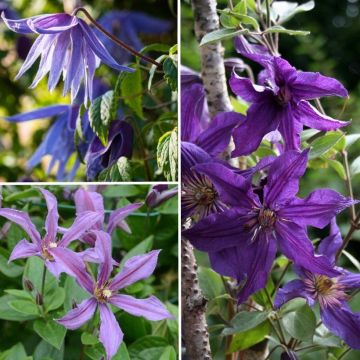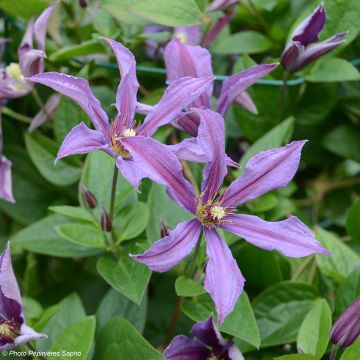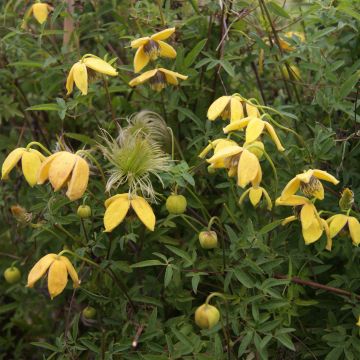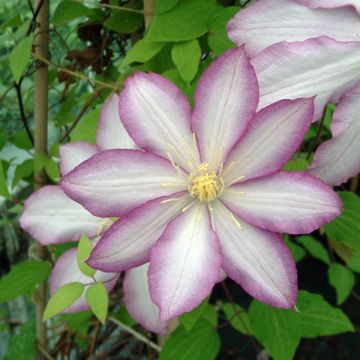

Clematis x diversifolia East River (Zoeastri)
Clematis East River
Clematis x diversifolia East River (Zoeastri)
Integrifolia Group Clematis, Diversifolia Clematis, Bush Clematis
Thanks to Hélène for preparing the order and Violette from the shipping department, the received clematis is in good health. Planted at the base of the "Synactif By Shisheido" rose bush, now I'm waiting for it to take root...
Thierry, 11/05/2022
Special offer!
Receive a €20 voucher for any order over €90 (excluding delivery costs, credit notes, and plastic-free options)!
1- Add your favorite plants to your cart.
2- Once you have reached €90, confirm your order (you can even choose the delivery date!).
3- As soon as your order is shipped, you will receive an email containing your voucher code, valid for 3 months (90 days).
Your voucher is unique and can only be used once, for any order with a minimum value of €20, excluding delivery costs.
Can be combined with other current offers, non-divisible and non-refundable.
Home or relay delivery (depending on size and destination)
Schedule delivery date,
and select date in basket
This plant carries a 6 months recovery warranty
More information
We guarantee the quality of our plants for a full growing cycle, and will replace at our expense any plant that fails to recover under normal climatic and planting conditions.
Would this plant suit my garden?
Set up your Plantfit profile →
Description
The East River Clematis (Zoeastri) is a rare and beautiful variety belonging to the group of diversifolia clematis that are more perennial plants than climbers. Its large, light purple flowers with pink highlights are distinguished by their graceful star-like silhouette with wavy branches. They are well displayed to reveal a very beautiful crown of light yellow stamens. This small climbing plant thrives on old walls, trellises and fences, but also as ground cover at the base of trees. Ideal when combined with a bush, in a container or in the ground. Its flowers last several days when cut.
Clematis belong to the buttercup family. 'East River' is a recent cultivar derived from Clematis diversifolia, a hybrid between Clematis integrifolia and various forms of C. viticella. It is a herbaceous, climbing perennial plant, reaching 1.50 m in height (slightly less in a pot), with a spread of 90 cm to 1 m. It is deciduous and completely dries out each winter, regrowing many stems from its crown in spring. It flowers from May to September.
The East River flowers measure 8 to 10 cm in diameter, appearing on the current year's shoots from May-June to September, either solitary or clustered in cymes. Each flower consists of 6 well-separated tepals, thin at the base, wavy at the edges, surrounding a core of prominent very pale yellow stamens. Feathery seed heads follow the flowers and persist until winter, they are decorative and silvery-grey. The leaves are simple and entire or divided into 3 leaflets, lanceolate to heart-shaped, of a fairly dark green. This clematis climbs on the support or host plant through petioles transformed into tendrils.
This 'East River' clematis can be used as a perennial plant, in a rock garden or a mixed border. Perfect growing in the branches of a shrub with staggered flowering (Compact Lilacs, mock oranges, deutzias...). Ideal for filling up a slightly sad creeping conifer in summer, this lovely plant can also adorn balconies, as it performs well in containers. Cut before full bloom, the flowers last up to 10 days in a vase.
Report an error about the product description
Clematis East River in pictures




Plant habit
Flowering
Foliage
Botanical data
Clematis
x diversifolia
East River (Zoeastri)
Ranunculaceae
Integrifolia Group Clematis, Diversifolia Clematis, Bush Clematis
Cultivar or hybrid
Planting and care
Clematis East River enjoys sunny exposures. As it blooms on the current year's branches, its vegetation should be pruned to 20 cm above the ground, above a nice pair of buds, in late winter (March), before the start of vegetation. Plant it in a fertile, humus-rich, and well-drained soil, shading the roots and the base of the stem (with a flat tile for example). Herbaceous species prefer full sun, but these plants like to keep their feet cool. However, they wilt in overly wet soil, so ensure good drainage for them.
Plant your clematis covering the root ball with 3 cm of soil, in soil worked to a depth of 20 cm, lightened with good compost and coarse sand. In the first few weeks, water regularly. Mulch all clematis in February with garden compost or well-rotted manure, avoiding direct contact with the stems. Cover the base of climbing clematis with a small mound of soil, to reduce the risk of wilting, while promoting the growth of vigorous shoots from the crown. After planting, cut back the stems of deciduous clematis to about 20 cm from the base above a nice pair of buds.
Do not overwater in winter, as stagnant water can cause fungus to develop at the collar. Train the stems, without crushing them, until the plant can cling by itself. Clematis also enjoy growing freely on neighbouring plants. Voles and slugs can attack clematis and devour the stems. Aphids and greenhouse whiteflies are also potential pests.
Planting period
Intended location
Care
-
, onOrder confirmed
Reply from on Promesse de fleurs
Similar products
Haven't found what you were looking for?
Hardiness is the lowest winter temperature a plant can endure without suffering serious damage or even dying. However, hardiness is affected by location (a sheltered area, such as a patio), protection (winter cover) and soil type (hardiness is improved by well-drained soil).

Photo Sharing Terms & Conditions
In order to encourage gardeners to interact and share their experiences, Promesse de fleurs offers various media enabling content to be uploaded onto its Site - in particular via the ‘Photo sharing’ module.
The User agrees to refrain from:
- Posting any content that is illegal, prejudicial, insulting, racist, inciteful to hatred, revisionist, contrary to public decency, that infringes on privacy or on the privacy rights of third parties, in particular the publicity rights of persons and goods, intellectual property rights, or the right to privacy.
- Submitting content on behalf of a third party;
- Impersonate the identity of a third party and/or publish any personal information about a third party;
In general, the User undertakes to refrain from any unethical behaviour.
All Content (in particular text, comments, files, images, photos, videos, creative works, etc.), which may be subject to property or intellectual property rights, image or other private rights, shall remain the property of the User, subject to the limited rights granted by the terms of the licence granted by Promesse de fleurs as stated below. Users are at liberty to publish or not to publish such Content on the Site, notably via the ‘Photo Sharing’ facility, and accept that this Content shall be made public and freely accessible, notably on the Internet.
Users further acknowledge, undertake to have ,and guarantee that they hold all necessary rights and permissions to publish such material on the Site, in particular with regard to the legislation in force pertaining to any privacy, property, intellectual property, image, or contractual rights, or rights of any other nature. By publishing such Content on the Site, Users acknowledge accepting full liability as publishers of the Content within the meaning of the law, and grant Promesse de fleurs, free of charge, an inclusive, worldwide licence for the said Content for the entire duration of its publication, including all reproduction, representation, up/downloading, displaying, performing, transmission, and storage rights.
Users also grant permission for their name to be linked to the Content and accept that this link may not always be made available.
By engaging in posting material, Users consent to their Content becoming automatically accessible on the Internet, in particular on other sites and/or blogs and/or web pages of the Promesse de fleurs site, including in particular social pages and the Promesse de fleurs catalogue.
Users may secure the removal of entrusted content free of charge by issuing a simple request via our contact form.
The flowering period indicated on our website applies to countries and regions located in USDA zone 8 (France, the United Kingdom, Ireland, the Netherlands, etc.)
It will vary according to where you live:
- In zones 9 to 10 (Italy, Spain, Greece, etc.), flowering will occur about 2 to 4 weeks earlier.
- In zones 6 to 7 (Germany, Poland, Slovenia, and lower mountainous regions), flowering will be delayed by 2 to 3 weeks.
- In zone 5 (Central Europe, Scandinavia), blooming will be delayed by 3 to 5 weeks.
In temperate climates, pruning of spring-flowering shrubs (forsythia, spireas, etc.) should be done just after flowering.
Pruning of summer-flowering shrubs (Indian Lilac, Perovskia, etc.) can be done in winter or spring.
In cold regions as well as with frost-sensitive plants, avoid pruning too early when severe frosts may still occur.
The planting period indicated on our website applies to countries and regions located in USDA zone 8 (France, United Kingdom, Ireland, Netherlands).
It will vary according to where you live:
- In Mediterranean zones (Marseille, Madrid, Milan, etc.), autumn and winter are the best planting periods.
- In continental zones (Strasbourg, Munich, Vienna, etc.), delay planting by 2 to 3 weeks in spring and bring it forward by 2 to 4 weeks in autumn.
- In mountainous regions (the Alps, Pyrenees, Carpathians, etc.), it is best to plant in late spring (May-June) or late summer (August-September).
The harvesting period indicated on our website applies to countries and regions in USDA zone 8 (France, England, Ireland, the Netherlands).
In colder areas (Scandinavia, Poland, Austria...) fruit and vegetable harvests are likely to be delayed by 3-4 weeks.
In warmer areas (Italy, Spain, Greece, etc.), harvesting will probably take place earlier, depending on weather conditions.
The sowing periods indicated on our website apply to countries and regions within USDA Zone 8 (France, UK, Ireland, Netherlands).
In colder areas (Scandinavia, Poland, Austria...), delay any outdoor sowing by 3-4 weeks, or sow under glass.
In warmer climes (Italy, Spain, Greece, etc.), bring outdoor sowing forward by a few weeks.








































